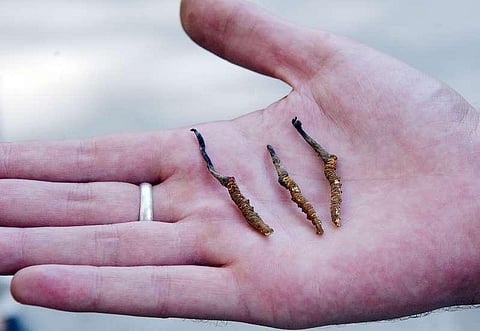

DEHRADUN: A recent study conducted by Uttarakhand state forest department has indicated that yeild of 'Himalayan Viagra' also known as Keeda jadi/Yartsa gunbu (Ophiocordyceps sinensis), valuable fungal herb which can be sold upto Rs 20 lakh per kilograms has drastically decreased from year 2010 to 2019.
"Keeda Jadi collection has drastically decreased from the year 2010 to 2019. The main reason for this may be illicit trade of Keeda Jadi or climatic change which can affect their growing numbers," stated the study titled 'A Report on Field Survey of Yartsa Gumba Extraction and it's Ecological Effect in Garhwal Himalayas'.
Sanjiv Chaturvedi, Magsaysay award winner Indian Forest Services officer who is heading the study by the research wing of the state forest department said, "The main reason behind drastic decline seems faulty extraction procedure. Last year a workshop was conducted in Pithoragarh to sensitize local communities to formulate regulations about the correct way of extraction of the valuable fungal herb".
The herb is found at an altitude of 12000 feet onwards in parts of Pithoragarh, Bageshwar and Chamoli districts in Uttarakhand.
The report of the study which was conducted in Joshimath block of Chamoli district was released earlier this week.
The study report is part of a 3-year research project which started in year 2018 aiming to explore multiple factors related to the valuable herb including its growth, yield, life cycle, extraction and effect of climate change.
In the recent survey, information was gathered from the Gram Sabha Raigarhi, which includes Karchi, Togashi and Raigarhi villages. The population of this Gram Sabha is about approximately 900 and it consists around 570 voters.
The study report pointed out that the members from each family travel 10 to 12 kilometers for keeda Jadi extraction in every harvesting season which is from the month of May to July.
The harvesting process is done mainly by young members, especially children of the family because it is easy for them to find it as the fungal herb remain embedded in the ground beneath the grassland.
The report states that in year 2010 one person on an average extracted 80 pieces of the herb per day in year 2010 which declined to 9 pieces per day in year 2019.
Drastic increase in price of the fungi is also attributed to its decline. Average price in year 2010 stood Rs 17.5 per piece which spiked to Rs 300 in year 2016. For year 2019, the prices stood Rs 200 per piece.
Earlier, on July 9, in a list released by International Union for Conservation of Nature’s (IUCN) Red List of Threatened Species placed the fungal herb in the ‘vulnerable’ category.
The reason for placing the fungi which is native to the eastern Himalayas in India, Bhutan, Nepal and Tibet in the vulnerable category has been cited as 'overharvesting' by the IUCN.
Believed to be a remedy for sexual impotency, according to traditional Chinese medicine (TCM), the fungus when boiled and added to tea or soup can act as an aphrodisiac, cure cancer and fight fatigue.
According to a study published in 'Nature', the global market for Yatrsa gunbu, ranges between USD 5 billion to USD 11 billion.